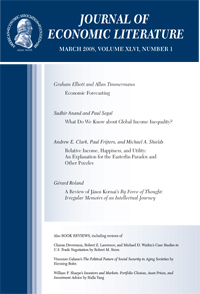测量时间偏好。
IF 11.5
1区 经济学
Q1 ECONOMICS
引用次数: 109
摘要
我们回顾了测量时间偏好的研究。,偏好高于跨期权衡。我们区分了使用资金流动的研究,我们称之为“钱的早或晚”(MEL)决策和使用时间标记的消费/努力的研究。在不同的结构模型下,我们展示了如何将MEL实验直接测量的内容(资金流动的所需收益率)转换为效用上的贴现函数。我们总结了MEL研究中发现的经验规律以及这些研究的预测能力。我们解释了为什么MEL选择在一定程度上是由一些不同于潜在时间偏好的因素驱动的。本文章由计算机程序翻译,如有差异,请以英文原文为准。
Measuring Time Preferences.
We review research that measures time preferences-i.e., preferences over intertemporal tradeoffs. We distinguish between studies using financial flows, which we call "money earlier or later" (MEL) decisions and studies that use time-dated consumption/effort. Under different structural models, we show how to translate what MEL experiments directly measure (required rates of return for financial flows) into a discount function over utils. We summarize empirical regularities found in MEL studies and the predictive power of those studies. We explain why MEL choices are driven in part by some factors that are distinct from underlying time preferences.
求助全文
通过发布文献求助,成功后即可免费获取论文全文。
去求助
来源期刊

Journal of Economic Literature
ECONOMICS-
CiteScore
17.80
自引率
0.80%
发文量
49
期刊介绍:
Commencing in 1969, the Journal of Economic Literature (JEL) serves as a vital resource for economists, offering a means to stay informed about the extensive literature in the field. Each JEL issue features commissioned, peer-reviewed survey and review articles, book reviews, an annotated bibliography categorizing new books by subject, and an annual index of dissertations from North American universities.
 求助内容:
求助内容: 应助结果提醒方式:
应助结果提醒方式:


